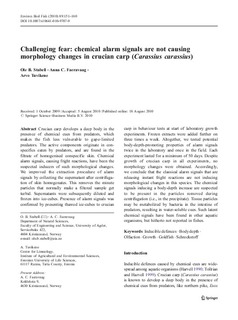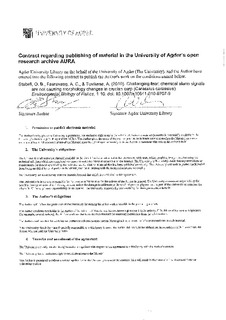| dc.contributor.author | Stabell, Ole B. | |
| dc.contributor.author | Faeravaag, Anna C. | |
| dc.contributor.author | Tuvikene, Arvo | |
| dc.date.accessioned | 2011-01-10T15:02:46Z | |
| dc.date.available | 2011-01-10T15:02:46Z | |
| dc.date.issued | 2010 | |
| dc.identifier.citation | Stabell, O. B., Faeravaag, A. C., & Tuvikene, A. (2010). Challenging fear: chemical alarm signals are not causing morphology changes in crucian carp (Carassius carassius). Environmental Biology of Fishes, 89(2), 151-160. doi: 10.1007/s10641-010-9707-9 | en_US |
| dc.identifier.issn | 0378-1909 | |
| dc.identifier.uri | http://hdl.handle.net/11250/138248 | |
| dc.description | Published version of an article in the journal: Environmental Biology of Fishes. Also available at SpringerLink: http://dx.doi.org/10.1007/s10641-010-9707-9 | en_US |
| dc.description.abstract | Crucian carp develops a deep body in the presence of chemical cues from predators, which makes the fish less vulnerable to gape-limited predators. The active components originate in conspecifics eaten by predators, and are found in the filtrate of homogenised conspecific skin. Chemical alarm signals, causing fright reactions, have been the suspected inducers of such morphological changes. We improved the extraction procedure of alarm signals by collecting the supernatant after centrifugation of skin homogenates. This removes the minute particles that normally make a filtered sample get turbid. Supernatants were subsequently diluted and frozen into ice-cubes. Presence of alarm signals was confirmed by presenting thawed ice-cubes to crucian carp in behaviour tests at start of laboratory growth experiments. Frozen extracts were added further on three times a week. Altogether, we tested potential body-depth-promoting properties of alarm signals twice in the laboratory and once in the field. Each experiment lasted for a minimum of 50 days. Despite growth of crucian carp in all experiments, no morphology changes were obtained. Accordingly, we conclude that the classical alarm signals that are releasing instant fright reactions are not inducing morphological changes in this species. The chemical signals inducing a body-depth increase are suspected to be present in the particles removed during centrifugation (i.e., in the precipitate). Tissue particles may be metabolized by bacteria in the intestine of predators, resulting in water-soluble cues. Such latent chemical signals have been found in other aquatic organisms, but hitherto not reported in fishes | en_US |
| dc.language.iso | eng | en_US |
| dc.publisher | Springer | en_US |
| dc.title | Challenging fear: Chemical alarm signals are not causing morphology changes in crucian carp (Carassius carassius) | en_US |
| dc.type | Journal article | en_US |
| dc.type | Peer reviewed | en_US |
| dc.subject.nsi | VDP::Agriculture and fishery disciplines: 900::Fisheries science: 920::Fish health: 923 | en_US |
| dc.subject.nsi | VDP::Mathematics and natural science: 400::Zoology and botany: 480::Marine biology: 497 | en_US |
| dc.source.pagenumber | 151-160 | en_US |

